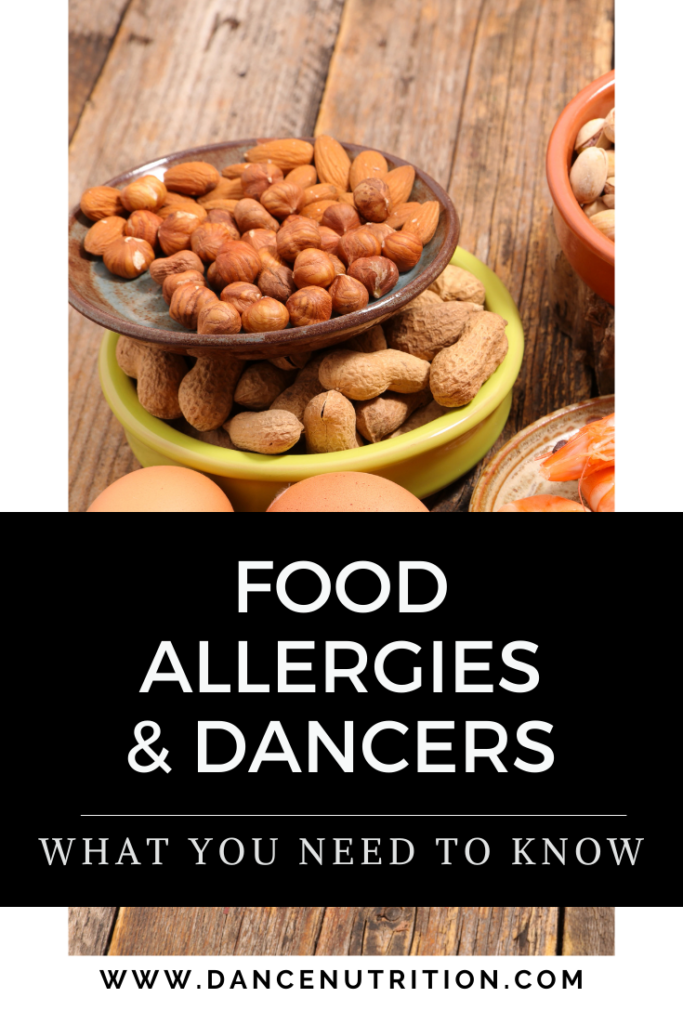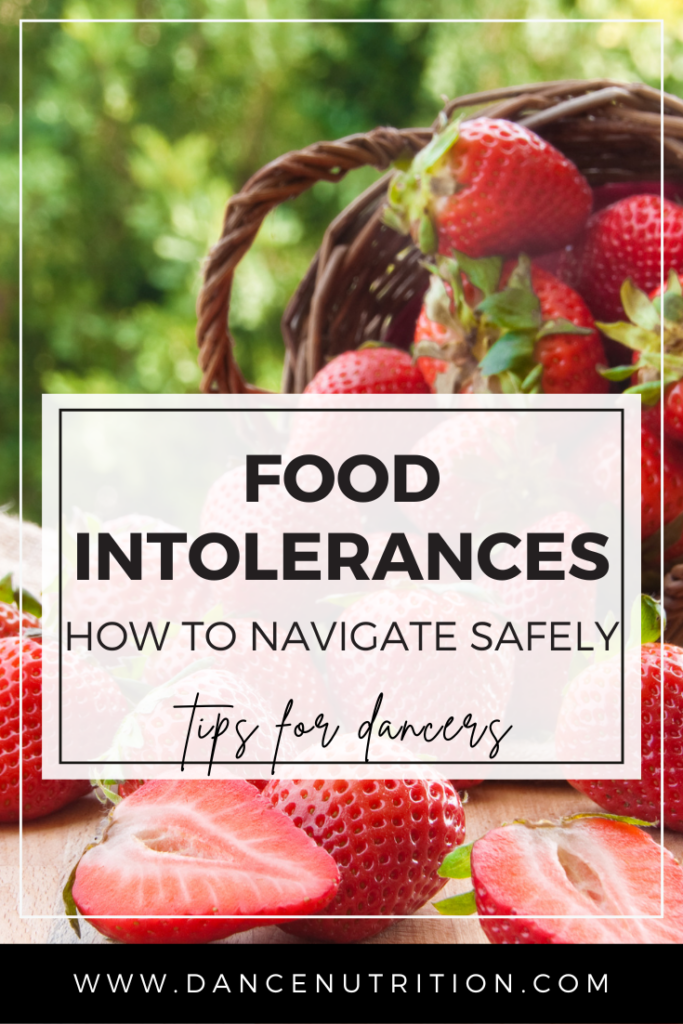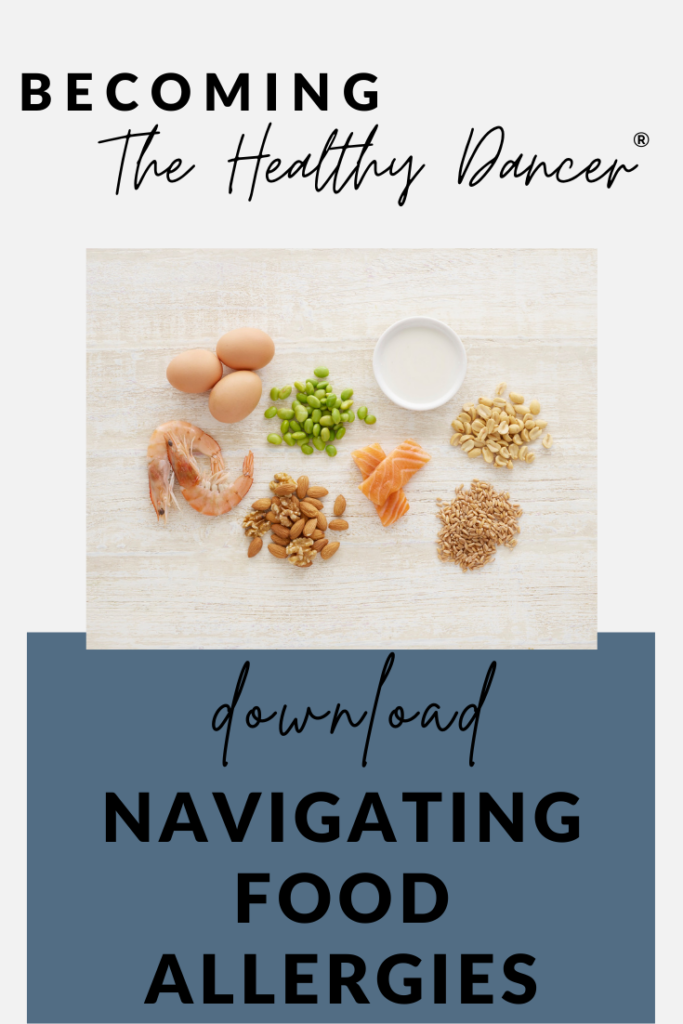Food allergies are serious and can be life-threatening. For dancers who have been medically diagnosed with one or more food allergies, constructing a nourishing meal plan can be challenging. This is further compounded when dancers face the reality of a busy and active schedule. This blog post deconstructs the nuances dancers face when navigating food allergies, along with practical tips for health and performance.
Make sure to grab your FREE downloadable guide to navigating food allergies below!
What are food allergies?
Food allergies involve the immune system reacting to certain proteins in foods as if they were harmful invaders. This reaction can cause a range of symptoms from mild (hives, itching) to severe (anaphylaxis). Eight major food allergens are responsible for the most serious food allergy reactions in the United States (learn more about food allergy stats here). These include:
- Milk
- Eggs
- Peanut
- Tree nuts
- Wheat
- Soy
- Fish, and
- Shellfish
What are food intolerances?
Food intolerances, on the other hand, do not involve the immune system. They occur when the body has difficulty digesting certain foods, leading to symptoms like gas, bloating, diarrhea, and abdominal pain. Common intolerances include:
- Lactose (found in dairy)
- Gluten (found in wheat, barley, and rye)
- FODMAPs (fermentable oligosaccharides, disaccharides, monosaccharides, and polyols)
I previously discussed a similar subject on food sensitivities, including how they’re diagnosed and ultimately, treated. Click here to give it a read.
Help! I Suspect An Intolerance
When self-diagnosing food allergies and intolerances, dancers face a unique risk of falling into restrictive eating. Unequivocal pressures of body aesthetics make it tempting to use these diagnoses as socially acceptable reasons to avoid foods in hopes of controlling weight. If you’re concerned about a potential intolerance or allergy, you’ll want to consult a medical professional first. Here are articles that dive further into these common concerns:
What about gluten, dairy, and sugar?
There are legitimate reasons why a dancer might need to avoid gluten (like being diagnosed with Celiac disease). Also, dancers struggling with lactose intolerance often find relief from reducing or omitting dairy from their diets. But going gluten- or dairy-free without a medically-diagnosed allergy or intolerance can be a slippery slope into disordered eating. Food intolerance tests (IgA tests) are largely unproven. These tests are expensive, not covered by insurance, and reflective of exposure to certain allergens (without enough evidence for diagnosis).
Regarding sugar, despite rare exceptions (like fructose malabsorption), intolerances to sugar are extremely uncommon. Since sugar is the body’s primary fuel source, especially for active dancers, any suspected need for avoidance should be taken up with a licensed professional (like a Registered Dietitian Nutritionist). Here’s an article uncovering everything you should know about suspected gluten and dairy intolerances.
Preparedness: Allergy Emergencies
For dancers with severe allergies, it’s important to communicate your dietary needs and inform studio owners and teachers about your allergies or intolerances. Carrying an emergency kit is non-negotiable.
- EpiPen: If prescribed, always have it on hand and know how to use it.
- Medical ID Bracelet: Wear it to inform others of your allergy in case of an emergency.
- Action Plan: Have a clear plan in place for managing allergic reactions.
Navigate allergy-free zones
For dancers who do not have food allergies, the impact can still be felt among allergy-free zones. In response to the rise in food allergies, some dance schools require omitting high-allergen foods (like peanuts and tree nuts) from their studios. Since peanuts and tree nuts are convenient snacks for dancers (especially those choosing a plant-based lifestyle), it can be difficult to construct replacements that offer a comparable nutritional profile.
But with one in thirteen children struggling with a serious food allergy, we must support each other and respect the rules of an allergy-free zone. Luckily, you can adequately fuel despite omitting common allergens. Here are some favorite allergy-friendly snacks to consider. And if you’d like to learn more about common allergen food swaps, download this free guide.
Allergy-friendly Studio snacks
- Edamame, either in the pods or shelled drizzled with EVOO and a dash of sea salt
- Chia seed pudding blended with cinnamon, vanilla, seed butter, and plant-based milk.
- Banana slices topped with sun butter.
- Smoothies made with coconut milk, protein powder, frozen fruit, ground flax, and greens.
- Veggies and crackers with hummus.
- Veggies and crackers with sunflower seed butter.
- Legume pasta can be made with a variety of sauces.
- Homemade Energy Bites: mix ½ cup of rolled oats, ¼ cup sunflower seed butter, 2 tablespoons shelled hemp seeds, 2 tablespoons chia, 1 tablespoon ground flax, 3 tablespoons chocolate chips, and a dash of sea salt. Roll into balls (1-inch circumference) and roll through a flour mixture of 2 tablespoons ground flaked cereal (I use Kashi Sprouted Flakes) and 2 tablespoons ground oats.
Intuitive Eating With Allergies and Intolerances: What’s Possible?
Balancing a supportive relationship with food while avoiding food allergens adds another complexity. If diagnosed with a food intolerance, food sensitivity, or food allergy, then you’ll want to prevent your restrictions from crossing paths with disordered eating. To do so, here are two steps to consider while navigating your diet:
#1: Set Practical Intentions
Reframe your reasons for avoidance. When one struggles with food intolerances, for example, the choice to avoid food is based upon a previous experience of not feeling well. Shift your thinking from a rule like “I am never allowed to eat ____” to a choice: “I choose not to eat ____ because, in the past, I’ve experienced major stomach discomfort.” Food avoidance should not be for “dieting,” but rather to keep you feeling physically well.
#2: Think about Abundance; Not Scarcity
The purpose of building a lifestyle without food rules is, among other reasons, to lessen if not eradicate the stress around eating. Dancers with food sensitivities, however, must consider their foods’ impact on physical functioning. Food allergies and intolerances can make some feel left out of certain celebrations and holiday traditions.
It can be easy to focus on the foods one is not allowed to eat. Instead, think about the abundance of foods one can eat and how these foods can be made more accessible. For example, choose allergy-friendly restaurants and suggest allergy-friendly dishes for parties and social gatherings. Luckily, our food supply is becoming increasingly accommodating to common allergens. Food substitutes like dairy-free ice cream and gluten-free bagels are widely available and make great options. If you feel that your intolerance or allergy prevents you from eating “fun foods” like baked goods, ice cream, and nutty desserts remember: you’re only avoiding the allergen commonly incorporated into these foods. Allergen-free alternatives are now widely available.
Key Takeaways
Food allergies can bring about many food-related complexities for dancers. This is especially true for those simultaneously healing their relationships with food. Your increased awareness of food is to keep you safe. It is not annoying nor unreasonable to question and double-check that food options are allergen-free. Those around you should respect this. You are becoming the expert of your own body and therefore must advocate for yourself.
If you’ve been medically diagnosed with a food allergy, it’s encouraged that you reach out for professional support. A Registered Dietitian Nutritionist can help. For more assistance with navigating your allergy or intolerance, here are a few additional resources to check out:
- The Allergy Chef offers awesome advice for navigating allergies in the kitchen.
- Dietitian Kate Scarlata provides many comprehensive guides and articles on her website.
- The Food Allergy Therapy network offers a registry of mental health therapists specializing in food allergies.
- For a few dancer-specific starter tips, grab your guide here:





